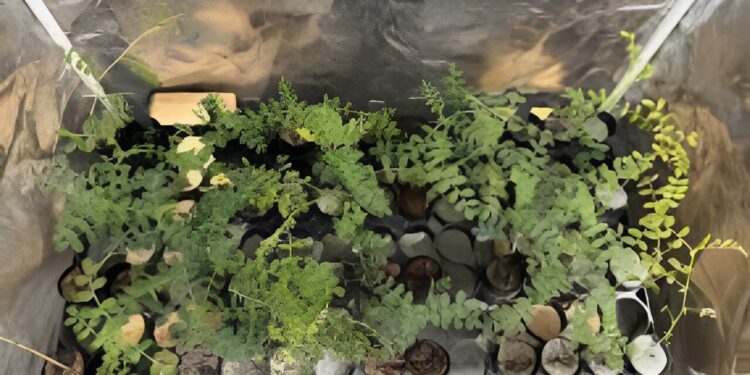Credit: Texas A&M AgriLife photo by Jessica Atkin
Her love for space exploration led Jessica Atkin, a Texas A&M College of Agriculture and Life Sciences graduate student in the Department of Soil and Crop Sciences, to produce the first-ever chickpeas grown from moon dust.
Jessica Atkin, a graduate student in the Department of Soil and Crop Sciences at Texas A&M, was able to produce the first chickpea seeds in a 75% mixture of simulated moon dust.
Using simulated moon dust, because there is not enough lunar regolith on Earth for experimentation, Atkin and his colleagues grew chickpeas in mixtures containing up to 75 percent moon dust. moon – a revolutionary enterprise in many respects.
Thanks to his study, future astronauts who travel to the Moon may have the opportunity to replace some of their prepackaged foods with proteins derived from crops grown on the lunar surface.
“The Moon doesn’t have a floor like Earth,” Atkin said. “On Earth, soil contains organic matter filled with nutrients and microorganisms that support plant growth. These are lacking on the Moon. This adds to other challenges, such as reduced gravity, radiation and toxic elements.”
To help address some of these challenges, Atkin developed a soil amendment to improve the structure and nutritional composition of moon dust, making it suitable for growing crops.
Atkin collaborated on the project with Sara Oliveira Santos, a doctoral student at Brown University, who brought expertise in solving hydrological problems arising from the small particle size of moon dust.
Moon dust research
Atkin worked on this research under the guidance of his advisors, Terry Gentry, Ph.D., a soil and water microbiologist in the Department of Soil and Crop Sciences, and Betsy Pierson, Ph.D., an expert in plant microbiology. interactions within the Department of Horticultural Sciences. Also contributing to the research is George Vandemark, Ph.D., a pulse breeder at the U.S. Department of Agriculture and a faculty member at Washington State University in Pullman, Washington.
Different degrees of chlorophyll can be seen in the chickpea moondust study after five weeks.
Jessica Atkin, a graduate student in the Department of Soil and Crop Sciences at Texas A&M, was able to produce the first chickpea seeds in a 75% mixture of simulated moon dust. Credit: Texas A&M AgriLife photo by Jessica Atkin
Using Earth’s soil regeneration mechanisms, Atkin harnessed the interaction between beneficial soil fungi and vermicompost, or worm manure, to create fertile moon dust. These amendments help sequester toxic contaminants from dust, modify soil structure for better hydraulic properties, and increase plant tolerance to stressors and toxins.
Three main actions help mushrooms fight against elemental contamination. First, the toxins are sequestered and bound in the soil mixture, making them less available for uptake by plants. This prevents contaminants from being absorbed by plant roots. If a toxin escapes, the fungus traps it in its own biomass and that of the plant’s roots, thereby limiting the amount of toxins absorbed by vegetation and seeds.
Vermicompost is used to provide nutrients and modify the physical properties of the moon dust composition. Atkin said red worms can be taken to the moon, where they can break down biowaste such as clothing, hygiene items and food scraps created by astronauts.
Atkin said she chose chickpeas because they are legumes that have beneficial relationships with mushrooms.
“They are a great source of protein and use less water and nitrogen than other food crops,” she said. “We used a variety of desi chickpeas to cope with space constraints inside a habitat.”
Using these techniques, Atkin successfully grew chickpeas with up to 75% lunar regolith simulant, a documented first. However, she noted a caveat: Although chickpeas typically take about 100 days to produce on Earth, in the lunar mixtures they took 120 days to mature and all the plants showed symptoms of stress.
Sustainability in space
Atkin said she would continue to study multigenerational effects and believed that once the soil matrix was transformed, it could lead to the possibility of growing other crops.
Although Atkin said there are many variables, this could provide a solution for long-term waste reduction and sustainability of lunar travel and exploration.
“The novelty of using vermiculture is that all of this can be done in space, whether in a space station or on the Moon, reducing the need for resupply missions,” she said .
Provided by Texas A&M University
Quote: From lunar ‘dust’ to lunar ‘soil’: Graduate student grows chickpeas in modified lunar dust (January 31, 2024) retrieved January 31, 2024 from
This document is subject to copyright. Except for fair use for private study or research purposes, no part may be reproduced without written permission. The content is provided for information only.



